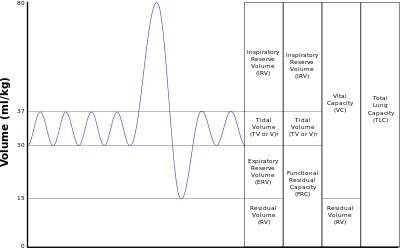Tidal volume
 | |
| TLC | Total lung capacity: the volume in the lungs at maximal inflation, the sum of VC and RV. |
|---|---|
| TV | Tidal volume: that volume of air moved into or out of the lungs during quiet breathing (VT indicates a subdivision of the lung; when tidal volume is precisely measured, as in gas exchange calculation, the symbol VT or VT is used.) |
| RV | Residual volume: the volume of air remaining in the lungs after a maximal exhalation |
| ERV | Expiratory reserve volume: the maximal volume of air that can be exhaled from the end-expiratory position |
| IRV | Inspiratory reserve volume: the maximal volume that can be inhaled from the end-inspiratory level |
| IC | Inspiratory capacity: the sum of IRV and TV |
| IVC | Inspiratory vital capacity: the maximum volume of air inhaled from the point of maximum expiration |
| VC | Vital capacity: the volume of air breathed out after the deepest inhalation. |
| VT | Tidal volume: that volume of air moved into or out of the lungs during quiet breathing (VT indicates a subdivision of the lung; when tidal volume is precisely measured, as in gas exchange calculation, the symbol VT or VT is used.) |
| FRC | Functional residual capacity: the volume in the lungs at the end-expiratory position |
| RV/TLC% | Residual volume expressed as percent of TLC |
| VA | Alveolar gas volume |
| VL | Actual volume of the lung including the volume of the conducting airway. |
| FVC | Forced vital capacity: the determination of the vital capacity from a maximally forced expiratory effort |
| FEVt | Forced expiratory volume (time): a generic term indicating the volume of air exhaled under forced conditions in the first t seconds |
| FEV1 | Volume that has been exhaled at the end of the first second of forced expiration |
| FEFx | Forced expiratory flow related to some portion of the FVC curve; modifiers refer to amount of FVC already exhaled |
| FEFmax | The maximum instantaneous flow achieved during a FVC maneuver |
| FIF | Forced inspiratory flow: (Specific measurement of the forced inspiratory curve is denoted by nomenclature analogous to that for the forced expiratory curve. For example, maximum inspiratory flow is denoted FIFmax. Unless otherwise specified, volume qualifiers indicate the volume inspired from RV at the point of measurement.) |
| PEF | Peak expiratory flow: The highest forced expiratory flow measured with a peak flow meter |
| MVV | Maximal voluntary ventilation: volume of air expired in a specified period during repetitive maximal effort |
Tidal volume is the lung volume representing the normal volume of air displaced between normal inhalation and exhalation when extra effort is not applied. In a healthy, young adult, tidal volume is approximately 500 ml per inspiration or 7 ml/kg of body weight.[1]
Mechanical ventilation
Tidal volume plays a significant role during mechanical ventilation to ensure adequate ventilation without causing trauma to the lungs. Tidal volume is measured in milliliters and ventilation volumes are estimated based on a patient's ideal body weight. Measurement of tidal volume can be affected (usually overestimated) by leaks in the breathing circuit or the introduction of additional gas, for example during the introduction of nebulized drugs.
Ventilator-induced lung injury such as ALI/ARDS can be caused by ventilation with very large tidal volumes in normal lungs, as well as ventilation with moderate or small volumes in previously injured lungs, and research shows that the incidence of ALI increases with higher tidal volume settings in nonneurologically-impaired patients. [2]
Initial settings of mechanical ventilation:
For patient without preexisting lung disease
Use the rule of 12-12, meaning 12 ml/kg is programmed to be delivered 12 times a minute in the assist control mode.
=For patients with chronic obstructive lung disease===+_+_+_+++
Use the rule of 10-10, meaning 10 ml/kg is programmed to be delivered 10 times a minute in the assist control mode.
Acute respiratory distress syndrome
There is strong evidence that limiting tidal volume to 6-8 ml/kg may be beneficial in the management of ARDS. In ARDS Mechanical ventilation with low tidal volumes and high positive end expiratory pressure (PEEP) is a mainstay of therapy. PEEP levels of up to 15 cm H2O are used.
External links
- Ricard JD (May 2003). "Are we really reducing tidal volume--and should we?". The American Journal of Respiratory and Critical Care Medicine 167 (10): 1297–8. doi:10.1164/rccm.2303003. PMID 12738592. Retrieved 2012-05-19.
References
- ↑ Beardsell, I et al: MCEM Part A:MCQs, page 33, Royal Society of Medicine Press, 2009
- ↑ Gajic, Ognjen; Saqib Dara, Jose Mendez, Abedola Adensanya, Emir Festic, Sean Caples, Rimki Rana, Jennifer StSauver, James Lymp, Bekele Afessa (2004). "Ventilator-associated lung injury in patients without acute lung injury at the onset of mechanical ventilation". Critical Care Medicine- Baltimore 32 (9): 1817–1824.